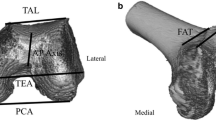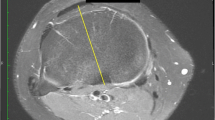Abstract
Purpose
Various rotational landmarks including the surgical epicondylar axis (SEA) are used for preoperative planning and intra-operative reference of total knee arthroplasty (TKA) in the axial plane. The aim of the study was to elucidate the relationships between the SEA and other femoral anatomical landmarks, including the mechanical axis, distal and posterior knee joints, the trochlear groove, and the anterior femoral condyle, in both the coronal and axial planes.
Methods
Angular and linear measurements were taken of sixty femora using Orthomap3D, which has a tool to analyse computed tomography image data that makes it possible to measure three-dimensional distances and angles precisely. The inter- and intra-observer reliabilities of these measurements were evaluated. Comparisons were made according to height, weight, body mass index, and gender.
Results
The angle between the mechanical axis and the SEA was 90.2° (95 % CI 90.0°–90.4°). There was a significant correlation for each linear measurement between the SEA and the distal/posterior knee joint line and for each linear measurement between the SEA and the anterior medial/lateral femoral condyle. A significant difference was observed between genders in the linear measurements. Significant correlations were found between height and weight and linear parameters.
Conclusion
Knowledge of the relationships between the SEA and other femoral anatomical landmarks is useful in preoperative planning, intra-operative landmark, and postoperative assessment of TKA. The SEA is a consistent parameter of femoral alignment in the coronal plane and a stable reference for femoral rotation in the axial plane.
Level of evidence
III.

Similar content being viewed by others
References
Barrack RL, Schrader T, Bertot AJ, Wolfe MW, Myers L (2001) Component rotation and anterior knee pain after total knee arthroplasty. Clin Orthop Relat Res 392:46–55
Berger RA, Rubash HE, Seel MJ, Thompson WH, Crossett LS (1993) Determining the rotational alignment of the femoral component in total knee arthroplasty using the epicondylar axis. Clin Orthop Relat Res 286:40–47
Brattstrom H (1964) Shape of the intercondylar groove normally and in recurrent dislocation of the patella; a clinical and X-ray anatomical investigation. Acta Orthop Scand Suppl 68:1–148
Colle F, Bignozzi S, Lopomo N, Zaffagnini S, Sun L, Marcacci M (2012) Knee functional flexion axis in osteoarthritic patients: comparison in vivo with transepicondylar axis using a navigation system. Knee Surg Sports Traumatol Arthrosc 20:552–558
Conley S, Rosenberg A, Crowninshield R (2007) The female knee: anatomic variations. J Am Acad Orthop Surg 15:S31–S36
Eckhoff DG, Bach JM, Spitzer VM, Reinig KD, Bagur MM, Baldini TH, Rubinstein D, Humphries S (2003) Three-dimensional morphology and kinematics of the distal part of the femur viewed in virtual reality. J Bone Joint Surg Am 85-A:97–104
Fehring TK, Odum SM, Hughes J, Springer BD, Beaver WB Jr (2009) Differences between the genders in the anatomy of the anterior condyle of the knee. J Bone Joint Surg Am 91:2335–2341
Griffin FM, Math K, Scuderi GR, Insall JN, Poilvache PL (2000) Anatomy of the epicondyles of the distal femur. J Arthroplast 13:354–359
Jeffery RS, Morris RW, Denham RA (1991) Coronal alignment after total knee replacement. J Bone Joint Surg Br 73-B:709–714
Jenny JY, Boeri C (2004) Low reproducibility of the intra-operative measurement of the transepicondylar axis during total knee replacement. Acta Orthop Scand 75:74–77
Kawahara S, Matsuda S, Okazaki K, Tashiro Y, Mitsuyasu H, Nakahara H, Iwamoto Y (2012) Relationship between the tibial anteroposterior axis and the surgical epicondylar axis in varus and valgus knees. Knee Surg Sports Traumatol Arthrosc 20:2077–2081
Kellgren JH, Lawrence JS (1957) Radiological assessment of osteo-arthrosis. Ann Rheum Dis 16:494–502
Landis JR, Koch GG (1977) The measurement of observer agreement for categorical data. Biometrics 33:159–174
Li K, Langdale E, Tashman S, Harner C, Zhang X (2012) Gender and condylar differences in distal femur morphometry clarified by automated computer analysis. J Orthop Res 30:686–692
Lombardi AV Jr, Nett MP, Scott WN, Clarke HD, Berend KR, O’Connor MI (2009) Primary total knee arthroplasty. J Bone Joint Surg Am 91-A:52–55
Luksanapruksa P, Rojvanit V, Sanpakit S (2012) Axial radiography of the normal distal femur for assessment of rotational alignment in Thai. J Med Assoc Thail 95:526–531
Lustig S, Lavoie F, Selmi TA, Servien E, Neyret P (2008) Relationship between the surgical epicondylar axis and the articular surface of the distal femur: an anatomic study. Knee Surg Sports Traumatol Arthrosc 16:674–682
Luyckx T, Zambianchi F, Catani F, Bellemans J, Victor J (2013) Coronal alignment is a predictor of the rotational geometry of the distal femur in the osteo-arthritic knee. Knee Surg Sports Traumatol Arthrosc 21:2331–2337
Matziolis G, Boenicke H, Pfiel S, Wassilew G, Perka C (2011) The gap technique does not rotate the femur parallel to the epicondylar axis. Arch Orthop Trauma Surg 131:163–166
Merchant AC, Arendt EA, Dye SF, Fredericson M, Grelsamer RP, Leadbetter WB, Post WR, Teitge RA (2008) The female knee. Clin Orthop Relat Res 466:3059–3065
Oussedik S, Scholes C, Ferguson D, Roe J, Parker D (2012) Is femoral component rotation in a TKA reliably guided by the functional flexion axis? Clin Orthop Relat Res 470:3227–3232
Pfitzner T, Rohner E, Preininger B, Perka C, Matziolis G (2012) Femur positioning in navigated total knee arthroplasty. Orthopedics 35:45–49
Pietsch M, Djahani O, Hochegger M, Plattner F, Hofmann S (2013) Patient-specific total knee arthroplasty: the importance of planning by the surgeon. Knee Surg Sports Traumatol Arthrosc 21:2220–2226
Poilvache PL, Insall JN, Scuderi GR, Font-Rodriguez DE (1996) Rotational landmarks and sizing of the distal femur in total knee arthroplasty. Clin Orthop Relat Res 331:35–46
Servien E, Viskontas D, Giuffre BM, Coolican MR, Parker DA (2008) Reliability of bony landmarks for restoration of the joint line in revision knee arthroplasty. Knee Surg Sports Traumatol Arthrosc 16:263–269
Stiehl JB, Abbott BD (1995) Morphology of the transepicondylar axis and its application in primary and revision total knee arthroplasty. J Arthroplast 10:785–789
Urabe K, Mahoney OM, Mabuchi K, Itoman M (2008) Morphologic differences of the distal femur between Caucasian and Japanese women. J Orthop Surg 16:312–315
Victor J (2009) Rotational alignment of the distal femur. Orthop Traumatol Surg Res 95:365–372
Yoshino N, Takai S, Ohtsuki Y, Hirasawa Y (2001) Computed tomography measurement of the surgical and clinical transepicondylar axis of the distal femur in osteoarthritic knees. J Arthroplast 16:493–497
Yoshioka Y, Siu D, Cooke TD (1987) The anatomy and function axes of the femur. J Bone Joint Surg Am 69-A:873–880
Yue B, Varadarajan KM, Ai S, Tang T, Rubash HE, Li G (2011) Gender differences in the knees of Chinese population. Knee Surg Sports Traumatol Arthrosc 19:80–88
Conflict of interest
None.
Author information
Authors and Affiliations
Corresponding author
Rights and permissions
About this article
Cite this article
Kobayashi, H., Akamatsu, Y., Kumagai, K. et al. The surgical epicondylar axis is a consistent reference of the distal femur in the coronal and axial planes. Knee Surg Sports Traumatol Arthrosc 22, 2947–2953 (2014). https://doi.org/10.1007/s00167-014-2867-y
Received:
Accepted:
Published:
Issue Date:
DOI: https://doi.org/10.1007/s00167-014-2867-y




